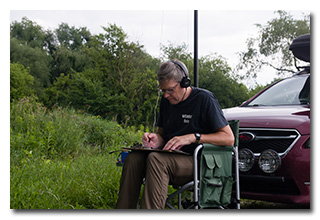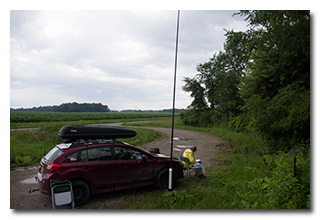
by William Eric McFadden
From the Willard Wildlife Area website:
-
Almost 13,000 acres of ancient bogland once surrounded the site of Willard Marsh Wildlife Area. During the last glaciation, some 25,000 years ago, a large, shallow lake was formed. This lake was originally a finger of glacial Lake Erie. As the rich, shallow-water vegetation decayed, plant material gradually filled the huge lake bed and northern bog plants such as sphagnum moss, cranberry, blueberry, royal and cinnamon ferns, and various sedges became established.
Gradual accumulation of bog vegetation resulted in deposits of peat which in some places reached a depth of 15 feet or more. This area was known locally as the “New Haven Marsh” or the “Huron Bog.” Fires have repeatedly burned over many parts of the bogland, and even today are a constant menace during the summer and fall. Most of the original bog has long since been drained for agriculture.
Pictures
- Eric operated—before donning raincoat; photo my Miles McFadden
- Eric operating—after donning raincoat; photo my Miles McFadden
Description
On Saturday, July 8, 2023, two members of the Southeast Ohio Radio Adventure Team performed a successful activation of Willard Wildlife Area (K-8271) in Ohio as part of the Parks on the Air (POTA; link) program.
Following a fun and successful morning spent at the Mansfield Mid*Summer Trunkfest, Eric McFadden, WD8RIF, and Miles McFadden, KD8KNC, visited the Willard Wildlife Area for a POTA activation.
Arriving at the Baseline Road parking area about 1915 UTC, Eric and Miles deployed the 228½' end-fed wire vertical on a 31' Jackite fiberglass mast in a drive-on base. Placing his Elecraft KX3 on the swing-up table of his folding camp-chair beneath the mast, Eric was on the air at 1935 UTC.
Eric was pleased to find he had good cell-signal at this location and would be able to spot himself on the POTA Spots website and to use POTA Spots to identify possible Park-to-Park (P2P) QSOs.
Eric began his operation on 40m by finding himself a frequency to run and began calling "CQ POTA", and was happy to see that he was quickly auto-spotted on POTA Spots. His first QSO came at 1942 UTC with N9DXP in Tennessee. (Shortly after this QSO, it started sprinkling, and Eric scrambled to put on a raincoat and, with Miles's help, find a piece of plastic sheet to protect the KX3.) QSOs came quickly, with Eric's eighth QSO coming at 1951 UTC with KB9RPG in Indiana. This run included QSOs with operators located in Tennessee, Michigan, Kentucky, New Jersey, North Carolina, Ontario, Virginia, and Indiana.
Swithing to 20m, Eric found himself a frequency to run and began calling "CQ POTA", and was again quickly auto-spotted on POTA Spots. His first QSO in this run came at 2000 UTC with NO5IG in Massachusetts. Realizing that he was being QRMed by digital signals, Eric found a new 20m frequency, updated his spot, and began calling "CQ POTA". His first QSO on the new frequency came at 2004 UTC with stalwart hunter KJ7DT in Idaho. This was followed at 2010 UTC by a QSO with K2WO in Florida.
In all, Eric made eleven QSOs in twenty-eight minutes. All of Eric's QSOs were CW and were made at five watts output.
Miles did not operate but helped with station set-up and tear-down and he did all the activation photography.
(return)

